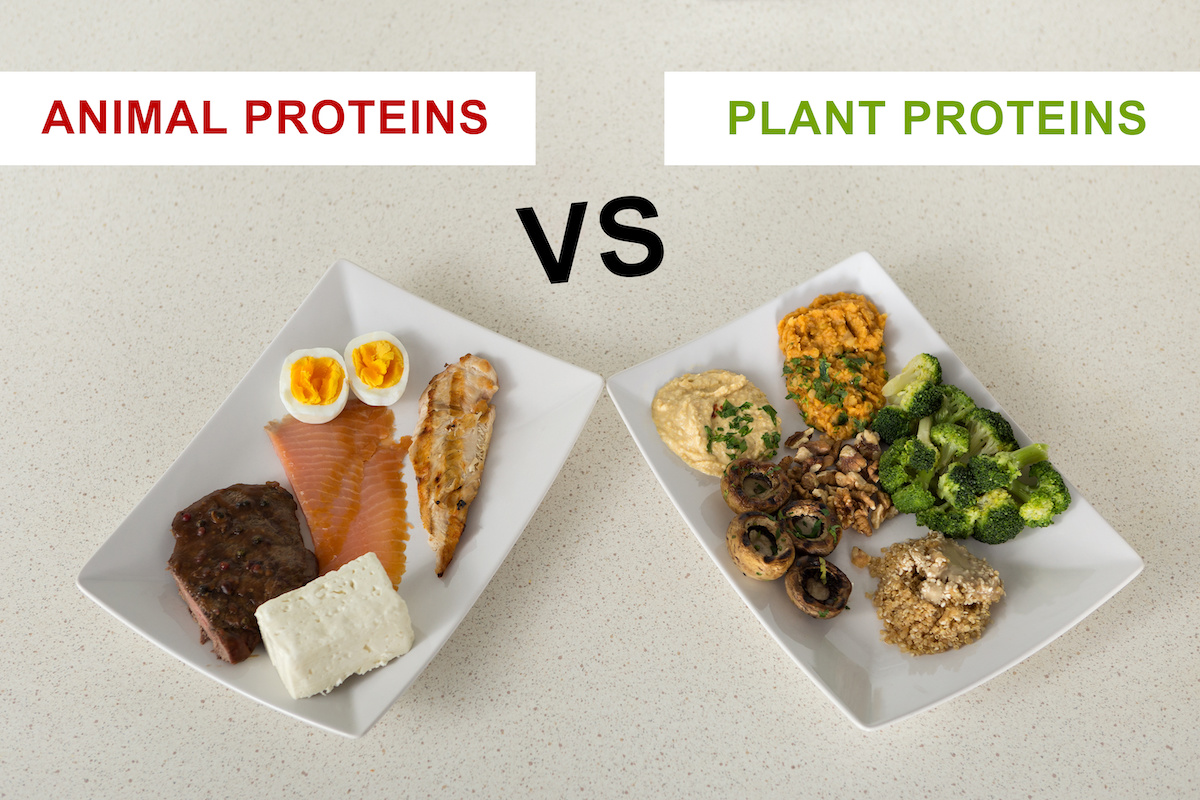Imagine a breakfast that’s not only delicious but also a powerhouse of nutrition. This isn’t a fantasy; it’s the exciting world of combining plant-based and animal proteins for a truly balanced and satisfying morning meal. We’ll explore creative ways to blend the richness of eggs or yogurt with the vibrant textures and nutrients of beans, nuts, or seeds, creating breakfast experiences that are both visually appealing and packed with essential amino acids. Get ready to discover recipes and techniques that elevate your breakfast game to a whole new level of flavor and health.
From the creamy smoothness of a chia seed pudding infused with Greek yogurt and berries to the satisfying crunch of a breakfast burrito brimming with scrambled tofu and black beans alongside a sprinkle of cheese, the possibilities are endless. We’ll delve into the nutritional benefits of this approach, providing a detailed look at complete protein profiles and essential amino acids, while also addressing potential dietary considerations and allergies. Prepare to unlock a world of flavorful and nutritious breakfast options that will leave you feeling energized and satisfied throughout your morning.
Breakfast Combinations
A balanced breakfast incorporating both plant-based and animal proteins offers a synergistic nutritional boost, providing a sustained energy release and a wider array of essential amino acids. This approach caters to diverse dietary needs and preferences, maximizing the benefits of each protein source. Combining these protein types ensures you receive a complete amino acid profile, crucial for muscle building, repair, and overall bodily functions.
Plant-Based and Animal Protein Sources for Breakfast
Choosing the right protein sources is key to a nutritious and satisfying breakfast. A variety of options ensures you don’t get bored and that you’re meeting your nutritional needs.
Five common plant-based protein sources ideal for breakfast include:
- Chia Seeds: These tiny powerhouses are packed with protein, fiber, and omega-3 fatty acids, adding a subtly nutty flavor and thickening agent to smoothies or yogurt.
- Greek Yogurt (Plant-Based): Many plant-based yogurts, made from soy, almond, or coconut milk, offer a creamy texture and significant protein content, perfect for a quick and easy breakfast.
- Tofu Scramble: Crumbled tofu, sautéed with vegetables, provides a hearty and protein-rich alternative to scrambled eggs, offering a blank canvas for flavor customization.
- Lentils: Cooked lentils can be added to breakfast bowls, providing a substantial dose of protein and fiber, contributing to satiety and sustained energy levels.
- Peanut Butter: A classic breakfast staple, peanut butter offers a good source of protein and healthy fats, adding richness and creaminess to toast or oatmeal.
Five common animal-based protein sources that are breakfast-friendly are:
- Eggs: A complete protein source, eggs are versatile and can be prepared in countless ways, from scrambled or fried to poached or boiled.
- Greek Yogurt (Dairy): Dairy-based Greek yogurt provides a high protein content, calcium, and probiotics, making it a nutritious and delicious breakfast choice.
- Cottage Cheese: This creamy cheese offers a significant protein boost and can be enjoyed plain or combined with fruits and nuts.
- Bacon/Sausage (Lean Cuts): While higher in fat, leaner cuts of bacon or sausage can be incorporated in moderation for a protein-rich breakfast, balanced with other nutrient-dense foods.
- Salmon (Smoked or Canned): A rich source of protein and omega-3 fatty acids, smoked or canned salmon can be added to bagels or avocado toast for a protein-packed breakfast.
Breakfast Combination Examples
Combining plant-based and animal proteins creates a nutritionally complete and flavorful breakfast.
Here are a few examples:
- Greek Yogurt (Dairy) with Berries and Chia Seeds: The dairy yogurt provides a substantial protein source, while the chia seeds add extra protein and fiber. The berries contribute antioxidants and natural sweetness.
- Oatmeal with Peanut Butter and a Scrambled Egg: Oatmeal provides fiber, peanut butter adds protein and healthy fats, and the egg contributes a complete protein profile, creating a well-rounded breakfast.
- Tofu Scramble with Smoked Salmon and Avocado Toast: The tofu scramble offers a plant-based protein source, the smoked salmon adds animal protein and healthy fats, and the avocado toast provides healthy fats and fiber.
- Breakfast Burrito with Lentils, Scrambled Eggs, and Vegetables: This hearty option combines the protein from lentils and eggs, with the added fiber and vitamins from vegetables, all wrapped in a whole-wheat tortilla.
Nutritional Comparison of Protein Sources
The table below compares the nutritional profiles of selected plant-based and animal protein sources, per 100g serving. Note that these values can vary depending on the specific product and preparation method.
| Protein Source | Protein (g) | Fiber (g) | Vitamins/Minerals (Examples) |
|---|---|---|---|
| Chia Seeds | 16-17 | 34 | Calcium, Iron, Magnesium, Phosphorus |
| Greek Yogurt (Dairy) | 10-15 | 0-1 | Calcium, Riboflavin, Potassium |
| Lentils | 26 | 7.9 | Iron, Folate, Potassium |
| Eggs | 12.6 | 0 | Vitamin D, Choline, Selenium |
| Salmon (Canned) | 20-25 | 0 | Vitamin D, Omega-3 Fatty Acids, Potassium |
| Cottage Cheese | 23-28 | 0 | Calcium, Riboflavin, Vitamin B12 |
Recipe Ideas
Successfully combining plant-based and animal proteins in breakfast offers a delicious and nutritious way to start your day. This approach ensures a balanced intake of essential amino acids, leading to sustained energy and improved satiety. The following recipes demonstrate creative ways to integrate these protein sources, resulting in flavorful and texturally diverse breakfast options.
Savory Greek Yogurt and Spinach Scramble
This recipe offers a vibrant, savory breakfast combining the creamy tang of Greek yogurt with the earthy notes of spinach and the satisfying heft of eggs. The preparation is quick and straightforward, perfect for busy mornings.
- Ingredients: 1 cup plain Greek yogurt (providing animal protein), 1 cup fresh spinach, 2 large eggs, 1/4 cup chopped red onion, 1 tablespoon olive oil, salt and pepper to taste.
- Instructions:
- Heat olive oil in a pan over medium heat.
- Sauté red onion until softened, about 3 minutes.
- Add spinach and cook until wilted, about 2 minutes.
- Whisk eggs in a bowl and season with salt and pepper.
- Pour eggs into the pan and cook, stirring occasionally, until set.
- Stir in Greek yogurt until heated through but not boiling. The yogurt will add creaminess and a subtle tang.
- Preparation Time: Approximately 10 minutes.
- Taste and Texture: The creamy Greek yogurt contrasts beautifully with the slightly crisp spinach and the fluffy eggs. The red onion adds a welcome sharpness, balancing the richness of the yogurt and eggs. The overall texture is soft and creamy, with a hint of pleasant crunch from the onion.
Berry Quinoa Breakfast Bowl with Cottage Cheese
This recipe provides a delightful balance of sweetness and tang, combining the nutty texture of quinoa with the refreshing burst of berries and the creamy texture of cottage cheese. The quinoa offers a significant plant-based protein boost.
- Ingredients: 1/2 cup cooked quinoa (providing plant-based protein), 1/2 cup cottage cheese (providing animal protein), 1/2 cup mixed berries (strawberries, blueberries, raspberries), 1 tablespoon chopped almonds, 1 teaspoon honey (optional).
- Instructions:
- Combine cooked quinoa and cottage cheese in a bowl.
- Top with mixed berries and chopped almonds.
- Drizzle with honey, if desired.
- Preparation Time: Approximately 5 minutes (assuming quinoa is pre-cooked).
- Taste and Texture: The slightly sweet and tangy berries complement the creamy cottage cheese and the nutty quinoa. The almonds add a satisfying crunch, providing textural contrast to the softer elements. The overall taste is refreshing and subtly sweet, with a pleasant mix of creamy and crunchy textures.
Avocado Toast with Smoked Salmon and Everything Bagel Seasoning
This recipe offers a sophisticated and satisfying breakfast that elegantly blends the richness of smoked salmon with the healthy fats and creaminess of avocado. The everything bagel seasoning adds a delightful savory depth.
- Ingredients: 1 slice whole-wheat toast, 1/4 avocado, mashed, 2 ounces smoked salmon (providing animal protein), 1 tablespoon everything bagel seasoning, a squeeze of lemon juice.
- Instructions:
- Toast the whole-wheat bread to your desired level of crispness.
- Spread mashed avocado evenly over the toast.
- Top with smoked salmon slices.
- Sprinkle generously with everything bagel seasoning.
- Finish with a squeeze of fresh lemon juice.
- Preparation Time: Approximately 5 minutes.
- Taste and Texture: The creamy avocado provides a luxurious base, contrasting beautifully with the salty, smoky flavor of the salmon. The everything bagel seasoning adds a complex layer of savory notes, enhancing the overall taste profile. The texture is a pleasing combination of creamy, soft, and slightly crunchy.
Nutritional Benefits and Considerations

Combining plant-based and animal proteins at breakfast offers a synergistic nutritional boost, optimizing your body’s access to essential amino acids and maximizing the benefits of each protein source. This strategic approach can lead to enhanced satiety, improved energy levels, and a stronger foundation for overall health throughout the day.
A balanced breakfast incorporating both protein types provides a complete amino acid profile, something that’s often difficult to achieve with plant-based proteins alone. This is because animal proteins are considered “complete” proteins, meaning they contain all nine essential amino acids your body needs but cannot produce on its own. Plant-based proteins, while rich in many essential amino acids, often lack one or more. Combining them strategically ensures you receive the full complement, maximizing protein synthesis and supporting various bodily functions.
Complete Protein Profiles and Essential Amino Acids
The nutritional synergy of combining plant and animal proteins is particularly evident in the context of essential amino acids. Animal sources like eggs, yogurt, or even a small amount of lean meat provide a readily available source of all nine essential amino acids. Plant-based options like beans, lentils, or nuts often lack one or more of these crucial building blocks. By pairing a plant-based source with an animal-based source, you create a complete protein profile, enhancing muscle growth, repair, and overall metabolic function. For instance, a breakfast of Greek yogurt with berries and a handful of almonds offers a balanced combination of complete and incomplete proteins, providing all essential amino acids.
Potential Challenges and Dietary Considerations
It’s crucial to acknowledge that incorporating both plant and animal proteins into breakfast isn’t always straightforward. Individual dietary needs and preferences play a significant role.
- Allergies: Some individuals have allergies to specific proteins, such as dairy, eggs, nuts, or soy. Careful consideration of potential allergens is vital when designing a breakfast plan that includes both plant and animal sources. For example, someone with a dairy allergy would need to substitute dairy-based animal protein with alternatives like tofu or alternative milks fortified with protein.
- Dietary Restrictions: Vegetarian, vegan, or other dietary restrictions may limit the inclusion of animal proteins. In these cases, focusing on complementary plant-based proteins that together provide a complete amino acid profile is essential. This might involve combining legumes with grains, or seeds with nuts. For example, a vegan breakfast might include a smoothie with soy milk, chia seeds, and hemp seeds to obtain a wider range of essential amino acids.
- Digestibility: While generally well-tolerated, some individuals might experience digestive discomfort when consuming a high quantity of both plant and animal proteins simultaneously. Starting with smaller portions and gradually increasing the intake can help assess individual tolerance levels and avoid any negative digestive effects. For instance, introducing a small portion of eggs with a small serving of beans, and monitoring any digestive discomfort can help to determine personal tolerance.
Mastering the art of combining plant-based and animal proteins in your breakfast opens a world of culinary creativity and nutritional benefits. By understanding the nutritional profiles of various protein sources and exploring diverse recipe ideas, you can craft breakfast meals that are not only delicious but also contribute to a balanced and healthy diet. Remember to consider individual dietary needs and preferences while experimenting with different flavor combinations and presentation styles to create your signature breakfast masterpiece. The journey to a healthier and more flavorful morning starts now!
FAQ Guide
What are some quick and easy ways to combine plant and animal proteins in breakfast?
Add a sprinkle of nuts or seeds to your yogurt parfait with granola and berries, or top your oatmeal with a dollop of cottage cheese. Scramble eggs with chopped vegetables and a side of whole-wheat toast with avocado.
Are there any potential downsides to combining plant and animal proteins?
Some individuals may have allergies or intolerances to certain protein sources. It’s crucial to be mindful of personal dietary restrictions and adjust recipes accordingly. Overconsumption of any protein source can also lead to digestive discomfort.
Can I combine plant and animal proteins if I’m vegetarian or vegan?
Vegetarians can incorporate animal proteins like eggs, dairy, or cheese. Vegans, however, will need to focus solely on plant-based protein sources for their breakfast meals.
How can I ensure I’m getting a complete protein profile from my breakfast?
Combine plant-based proteins with complementary amino acid profiles (e.g., legumes and grains) or include animal proteins, which are generally complete proteins.


